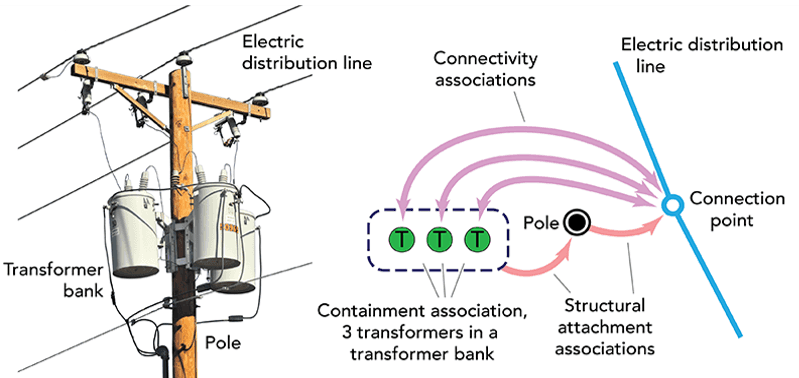Associations enable the modeling of connectivity, containment, and structure attachment between non-spatial and non-coincident network features. The following table describes the types of relationships between two utility network elements:
| Association | Description | Geometry supported |
|---|---|---|
| Connectivity | Models the connectivity between two junctions that don't have geometric coincidence (are not in the same x, y and z location). A transformer may be connected to a fuse, for example. | Yes |
| Structural attachment | Models equipment attached to structures. A transformer bank may be attached to a pole, for example. | Yes |
| Containment | Models assets that contain other assets. A vault may contain valves and pipes, for example. | No |

// Get the QList of utility association objects from the utility network via
// the associations async method (uses QFuture).
utilityNetwork->associationsAsync(utilityElement, UtilityAssociationType::Containment).then
(this, [] (const QList<UtilityAssociation*>& associations)
{
// Test if we have some utility associations.
if (associations.isEmpty())
return;
// Loop thru the utility associations.
for (UtilityAssociation* association : associations)
{
// Get the first ("from") and second ("to") elements in the association.
UtilityElement* fromElement = association->fromElement();
UtilityElement* toElement = association->toElement();
// Provide some feedback.
qDebug() << fromElement->assetType()->name() << " " << toElement->assetType()->name();
}
});
You can also provide an envelope to find all valid associations within the specified extent.
The following example creates a new graphics overlay to display all associations within the map extent using a unique symbol for each association type.
// Create symbols for the structural attachment and connectivity associations.
SimpleLineSymbol* attachmentSymbol = new SimpleLineSymbol
(
SimpleLineSymbolStyle::Dot, // style
QColor("green"), // color
5, // width
this // parent
);
SimpleLineSymbol* connectivitySymbol = new SimpleLineSymbol
(
SimpleLineSymbolStyle::Dot, // style
QColor("red"), // color
5, // width
this // parent
);
// Create a unique value renderer for the attachment value associations.
UniqueValue* attachmentValue = new UniqueValue
(
"Attachment", // label
"", // description
QVariantList{static_cast<int>(UtilityAssociationType::Attachment)}, // values
attachmentSymbol, // symbol
this // parent
);
// Create a unique value renderer for the connectivity value associations.
UniqueValue* connectivityValue = new UniqueValue
(
"Connectivity", // label
"", // description
QVariantList{static_cast<int>(UtilityAssociationType::Connectivity)}, // values
connectivitySymbol, // symbol
this // parent
);
// Create a unique value renderer for the associations.
UniqueValueRenderer* uniqueValueRenderer = new UniqueValueRenderer
(
"", // default label
nullptr, // default symbol
QStringList{"AssociationType"}, // field names
QList<UniqueValue*>{attachmentValue, connectivityValue}, // unique values
this // parent
);
// Create a graphics overlay for the associations.
GraphicsOverlay* associationsOverlay = new GraphicsOverlay(this);
// Get the graphics overlay list model from the map view.
GraphicsOverlayListModel* graphicsOverlayListModel = m_mapView->graphicsOverlays();
// Append the graphics overlay to the graphics overlay list model.
graphicsOverlayListModel->append(associationsOverlay);
// Set the unique value renderer for the graphics overlay.
associationsOverlay->setRenderer(uniqueValueRenderer);
// Get the current viewpoint from the map view.
const Viewpoint viewpoint = m_mapView->currentViewpoint(ViewpointType::BoundingGeometry);
// Get the geometry fomr the viewpoint.
const Geometry geometry = viewpoint.targetGeometry();
// Get the envelope from the view point's geometry.
const Envelope envelope = geometry.extent();
// Get the QList of utility association objects from the utility network via
// the associations async method (uses QFuture).
utilityNetwork->associationsAsync(envelope).then(this, [this, associationsOverlay]
(const QList<UtilityAssociation*>& associations)
{
// Loop thru the utility associations.
for (UtilityAssociation* association : associations)
{
// Test the association type and make sure it's not a containment relationship.
if (association->associationType() != UtilityAssociationType::Containment)
{
// Create a new graphic using the geometry from the association.
Graphic* graphic = new Graphic(association->geometry(), this);
// Get the attribute list model from the graphic.
AttributeListModel* attributeListModel = graphic->attributes();
// Add an attribute to the graphic.
attributeListModel->insertAttribute
(
"GlobalId", // attribute name - QString
association->globalId() // attribute value - QVariant
);
// Add another attribute to the graphic.
attributeListModel->insertAttribute
(
"AssociationType", // attribute name - QString
(int)association->associationType() // attribute value - QVariant
);
// Add a graphic for the association.
associationsOverlay->graphics()->append(graphic);
}
}
});
Specifying a utility element will return all its associations unless the utility element's terminal has been set, which limits the connectivity associations returned.
Specifying an extent will return all its connectivity or structural attachment associations with geometry. The geometry value (polyline) represents the connection relationship between a from element and a to element. You can use the geometry to visualize the association as a graphic in the map.

